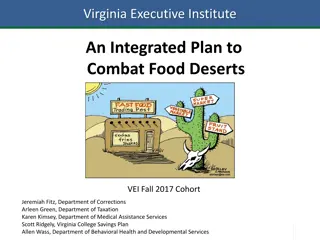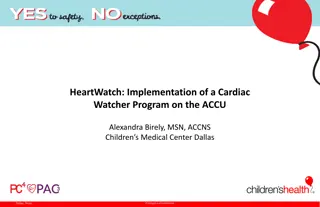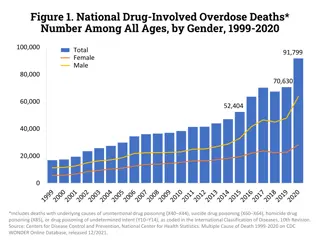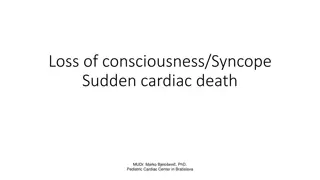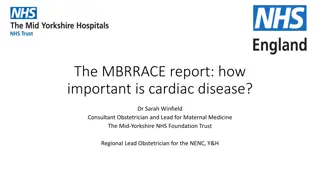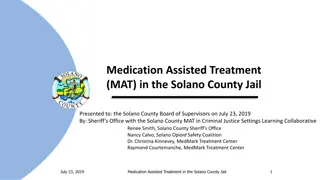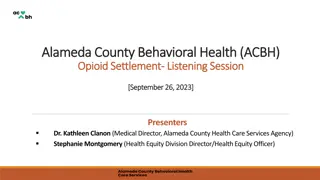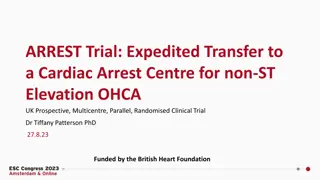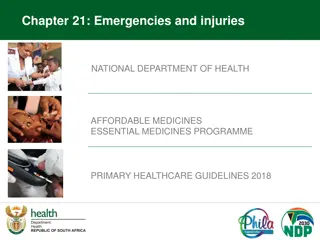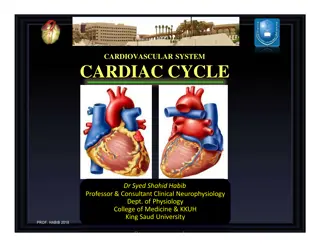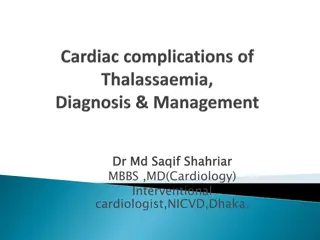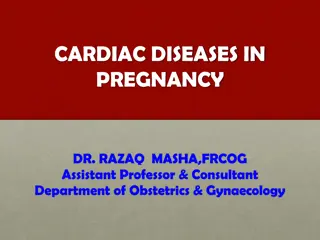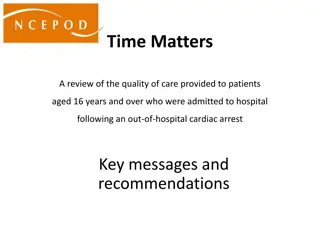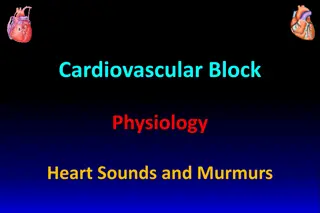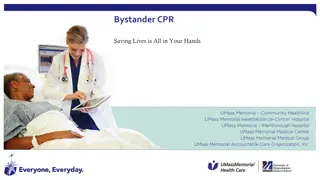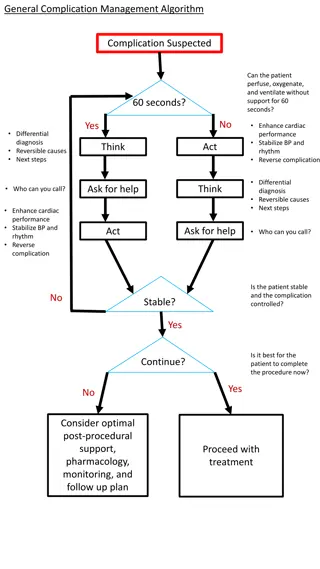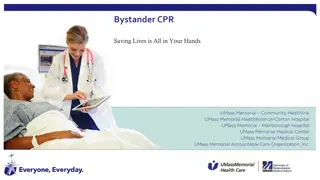Study on Cardiac Deaths and Food Deserts in Knox County, TN
This project aims to investigate the correlation between cardiac deaths and access to healthy foods in Knox County, TN. Utilizing Death Statistical Systems data and Census Tract Data from the 2010 census, the study examines age-adjusted rates to compare populations. The research is conducted in collaboration with the Office of Minority Health and Disparities Elimination in the Tennessee Department of Health as part of a student internship program at East Tennessee State University. By identifying low-income census tracts with limited access to supermarkets, the study sheds light on potential links between food deserts and cardiac health in the region.
Download Presentation

Please find below an Image/Link to download the presentation.
The content on the website is provided AS IS for your information and personal use only. It may not be sold, licensed, or shared on other websites without obtaining consent from the author. Download presentation by click this link. If you encounter any issues during the download, it is possible that the publisher has removed the file from their server.
E N D
Presentation Transcript
Cardiac Deaths and Food Deserts in Knox County, TN Emily Miller, Fred Croom, Tene Franklin Hamilton, Kimberly Glenn
Background This project is intended for the Office of Minority Health and Disparities Elimination in the Tennessee Department of Health as a product of a student internship. The work will be presented to East Tennessee State University as a sign of completing objectives defined by the College of Public Health for the required internship for the Master s program and is a part of the student s culminating experience.
Introduction This study hopes to address the link between cardiac deaths and access to healthy foods for Knox County, TN
Cardiac Deaths Definition For this study we used Death Statistical Systems data from Vital Records in the Tennessee Department of Health ICD-10 codes for myocardial infarction, heart failure, stroke, and coronary artery disease. The events were selected as being the Underlying Cause of Death, which includes codes: I21.0-I21.4, I21.9-122.1, I22.8- I23.6, I23.8; I11.0, I13.0, I42.0-I42.9, I50.0, I50.1, I50.9, I51.7; I60.0-I60.9, I61.0-I61.9, I63.0-I63.9, I64, I65.0- I65.9; I20.0, I20.8, I20.9, I21.0-I25.9 and I51.6.
Cardiac Deaths Age-Adjustment Since age is a risk factor associated with cardiac deaths it is important that we use age-adjusted rates in order to compare two populations
Census Tract Data from the 2010 census was used for demarcating populations within Knox County This was better than zip code data since these lines fall outside of county boundaries
Map of Census Tracts for Knox County Census Data from 2010 was used for this report
HFFI Food Desert Healthy Food Financing Initiative (HFFI) Low-income Census tracts that meet the Treasury Department s New Markets Tax Credit (NMTC) Low Access A substantial number of residence with low access to a supermarket or large grocery store
Map of Food Deserts for Knox County Using the Healthy Food Financing Initiative (HFFI) criteria to define the Census Tracts in Knox County that are considered a food desert.
Cardiac Deaths Quantile Distribution Using the cardiac death rates found they were then classified into 5 levels
Map of Cardiac Death Rates for Knox County Age adjusted cardiac death rates were calculated using SAS for each census tract. A quantile distribution of rates were used to classify into 5 levels
Cardiac Death Rates Compared to Food Deserts Comparing Rates between Census Tracts Using ArcMap to export data to excel a two-tailed t-test was used to assess the cardiac rates in census tracts considered to be food deserts and cardiac death rates in census tracts not considered to be a food desert
Map of Cardiac Death Rates for Knox County Cardiac Death Rates compared between census tracts considered to be a food desert and those that were not.
Cardiac Death Rates Compared to Food Deserts Comparing Rates between Census Tracts T-test resulted in a p-value of 0.078252 This shows significance with alpha= 0.10 Therefore we have 90% confidence that there is a significant difference between cardiac death rates for the food desert tracts compared to the non-food desert tracts However, we are not 95% confident
Healthy Food Retailer in Knox County To gain understanding of healthy food access, the location of healthy food retailers were obtained via communication with the Department of Agriculture
Healthy Food Retailer in Knox County List of all Food Retailers for Knox County was provided by the Department of Agriculture Food Retailers included in the study based upon definition of food retailers by the Department of Agriculture
Healthy Food Retailer in Knox County Inclusion: 23-Retail Fish Market-Deli 43-Meat Market-Deli 51-Market W Meat Dept & Deli 52-Market W Meat Dept & Deli, 50 or more seats 81-Market 82-Market W Food Service 101-Retail Produce Market 103-Retail Produce Market W Deli 141-Health Food Store
Healthy Food Retailer in Knox County Geocode Addresses The list of food retailers include addresses which were used to geocode their locations
Map of Healthy Food Retailers for Knox County The stars on the map depict the healthy food locations designated by the definition for type of food retail they get from the Department of Agriculture
Map of Healthy Food Retailers for Knox County One mile buffer was assigned to each healthy food retailer to better understand the healthy food distribution in Knox County
Map of Cardiac Death Rates for Knox County The healthy food retailers were added to the map in order to understand their relationship with cardiac deaths and with food deserts.
Results There is a significant difference in the rate of cardiac deaths for individuals living within a food desert compared to those living outside a food desert at the 90% confidence level.
Limitations Difficulty in defining food deserts
Discussions Because of the geographical nature of Knox county identifying food deserts can be difficult. Walkability improves access to retailers Increased
References CDC. Heart Disease facts. (2015) Heart Disease. Last updated: February 19, 2015. Retrieved from: http://www.cdc.gov/heartdisease/facts.htm. WHO. Cardiovascular diseases (CVDs). Media centre. Fact sheet N 317. Updated January 2015. Retrieved from: http://www.who.int/mediacentre/factsheets/fs317/en/. Mayo Clinic. Heart Disease. (2014) Diseases and Conditions. Retrieved from: http://www.mayoclinic.org/diseases-conditions/heart-disease/basics/definition/con-20034056. Definition of a food desert. United States Department of Agriculture. Economic Research Service. http://www.ers.usda.gov/dataFiles/Food_Access_Research_Atlas/Download_the_Data/Archived_Version/archived_documentation.pdf. Heath, G. W., & Troped, P. J. (2012). The role of the built environment in shaping the health behaviors of physical activity and healthy eating for cardiovascular health. Future Cardiology, 8(5), 677+. (doi: 10.2217/fca.12.52) Retrieved from: http://go.galegroup.com.ezproxy.etsu.edu:2048/ps/i.do?id=GALE%7CA303403368&v=2.1&u=tel_a_etsul&it=r&p=EAIM&sw=w&asid=a483820e0d805935703afc06fdc40841. Pedigo AS; Odoi A. Investigation of Disparities in Geographic Accessibility to Emergency Stroke and Myocardial Infarction Care in East Tennessee Using Geographic Information Systems and Network Analysis. Annals of Epidemiology , Volume 20 , Issue 12 , 924 930 Retrieved from: http://www.sciencedirect.com.ezproxy.etsu.edu:2048/science/article/pii/S104727971000164X. Erwin, P. C.; Fitzhugh, E. C.; Brown, K. C.; Looney, S.; Forde, T.(2010). Health Disparities in Rural Areas: The Interaction of Race, Socioeconomic Status, and Geography. Journal of Health Care for the Poor and Underserved 21(3), 931-945. The Johns Hopkins University Press. Retrieved from: https://muse-jhu- edu.ezproxy.etsu.edu:3443/journals/journal_of_health_care_for_the_poor_and_underserved/v021/21.3.erwin.html. Botchwey, N. D., Falkenstein, R., Levin, J., Fisher, T., & Trowbridge, M. (2014). The Built Environment and Actual Causes of Death Promoting an Ecological Approach to Planning and Public Health. Journal of Planning Literature, 0885412214561337. Auchincloss, A. H., Mujahid, M. S., Shen, M., Michos, E. D., Whitt Glover, M. C., & Diez Roux, A. V. (2013). Neighborhood health promoting resources and obesity risk (the multi ethnic study of atherosclerosis). Obesity, 21(3), 621-628. doi: 10.1002/oby.20255. Retrieved from: http://onlinelibrary.wiley.com/doi/10.1002/oby.20255/epdf. Diez Roux, A. V.; Merkin, S. S.; Arnett, D. ; Chambless, L.; Massing, M.; Nieto, F. J.; Sorlie, P.; Szklo, M.; Tyroler, H. A.; Watson, R. L. Neighborhood of Residence and Incidence of Coronary Heart Disease.. N Engl J Med 2001; 345:99-106July 12, 2001DOI: 10.1056/NEJM200107123450205. Retrieved from: http://www.nejm.org/doi/full/10.1056/NEJM200107123450205. Swinburn B, Sacks G, Gortmaker S, et al. The global obesity pandemic: shaped by global drivers and local environments. The Lancet [serial online]. 2011;(9793):804. Available from: InfoTrac Health Reference Center Academic, Ipswich, MA. https://www-clinicalkey-com.ezproxy.etsu.edu:3443/#!/content/playContent/1-s2.0-S0140673611608131. The Appalachian Region (2015). Appalachian Regional Commission. Retrieved from: http://www.arc.gov/appalachian_region/TheAppalachianRegion.asp.



